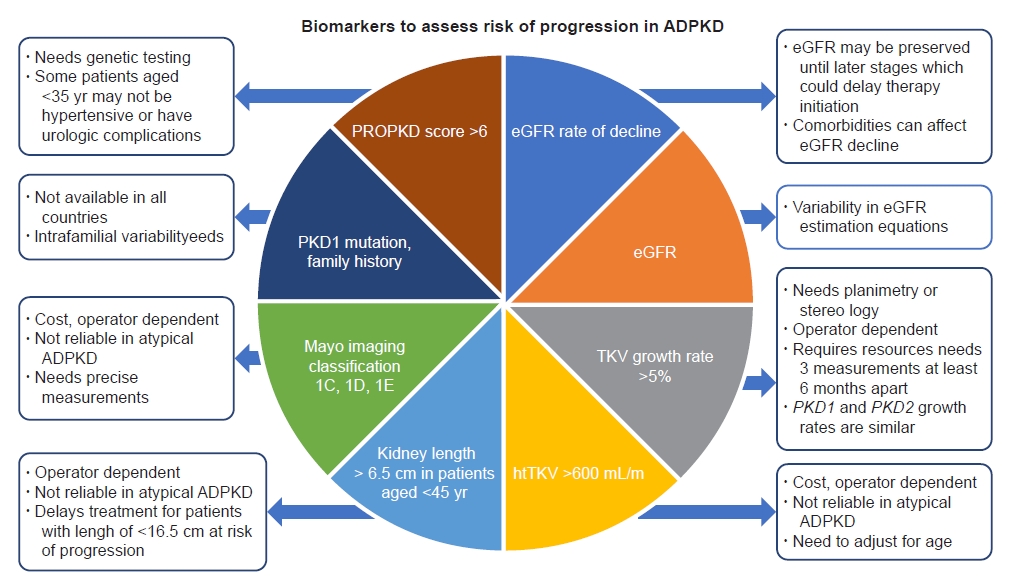1. Chapman AB, Devuyst O, Eckardt KU, et al. Autosomal-dominant polycystic kidney disease (ADPKD): executive summary from a Kidney Disease: Improving Global Outcomes (KDIGO) Controversies Conference.
Kidney Int 2015;88:17–27.



2. Colbert GB, Elrggal ME, Gaur L, Lerma EV. Update and review of adult polycystic kidney disease.
Dis Mon 2020;66:100887.


3. Rastogi A, Ameen KM, Al-Baghdadi M, et al. Autosomal dominant polycystic kidney disease: updated perspectives.
Ther Clin Risk Manag 2019;15:1041–1052.


4. Chebib FT, Torres VE. Autosomal dominant polycystic kidney disease: core curriculum 2016.
Am J Kidney Dis 2016;67:792–810.



5. Cornec-Le Gall E, Torres VE, Harris PC. Genetic complexity of autosomal dominant polycystic kidney and liver diseases.
J Am Soc Nephrol 2018;29:13–23.



6. Cornec-Le Gall E, Audrézet MP, Chen JM, et al. Type of PKD1 mutation influences renal outcome in ADPKD.
J Am Soc Nephrol 2013;24:1006–1013.



7. Rossetti S, Harris PC. Genotype-phenotype correlations in autosomal dominant and autosomal recessive polycystic kidney disease.
J Am Soc Nephrol 2007;18:1374–1380.


8. Bergmann C, Guay-Woodford LM, Harris PC, Horie S, Peters DJ, Torres VE. Polycystic kidney disease.
Nat Rev Dis Primers 2018;4:50.



9. Porath B, Gainullin VG, Cornec-Le Gall E, et al. Mutations in GANAB, encoding the glucosidase IIα subunit, cause autosomal-dominant polycystic kidney and liver disease.
Am J Hum Genet 2016;98:1193–1207.


10. Eckardt KU, Alper SL, Antignac C, et al. Autosomal dominant tubulointerstitial kidney disease: diagnosis, classification, and management: a KDIGO consensus report.
Kidney Int 2015;88:676–683.


11. Cornec-Le Gall E, Olson RJ, Besse W, et al. Monoallelic mutations to DNAJB11 cause atypical autosomal-dominant polycystic kidney disease.
Am J Hum Genet 2018;102:832–844.



12. Lanktree MB, Haghighi A, di Bari I, Song X, Pei Y. Insights into autosomal dominant polycystic kidney disease from genetic studies.
Clin J Am Soc Nephrol 2021;16:790–799.



13. Sharma S, Kalish JM, Goldberg EM, Reynoso FJ, Pradhan M. An atypical presentation of a male with oral-facial-digital syndrome type 1 related ciliopathy.
Case Rep Nephrol 2016;2016:3181676.



14. Srivastava S, Molinari E, Raman S, Sayer JA. Many genes-one disease?: genetics of nephronophthisis (NPHP) and NPHP-associated disorders.
Front Pediatr 2018;5:287.



15. Torres VE, Harris PC, Pirson Y. Autosomal dominant polycystic kidney disease.
Lancet 2007;369:1287–1301.


16. Gradzik M, Niemczyk M, Gołębiowski M, Pączek L. Diagnostic imaging of autosomal dominant polycystic kidney disease.
Pol J Radiol 2016;81:441–453.



17. Lanktree MB, Iliuta IA, Haghighi A, Song X, Pei Y. Evolving role of genetic testing for the clinical management of autosomal dominant polycystic kidney disease.
Nephrol Dial Transplant 2019;34:1453–1460.


18. Chebib FT, Torres VE. Assessing risk of rapid progression in autosomal dominant polycystic kidney disease and special considerations for disease-modifying therapy.
Am J Kidney Dis 2021;78:282–292.


19. Shukoor SS, Vaughan LE, Edwards ME, et al. Characteristics of patients with end-stage kidney disease in ADPKD.
Kidney Int Rep 2020;6:755–767.



20. Chapman AB. Approaches to testing new treatments in autosomal dominant polycystic kidney disease: insights from the CRISP and HALT-PKD studies.
Clin J Am Soc Nephrol 2008;3:1197–1204.


21. Grantham JJ, Torres VE, Chapman AB, et al. Volume progression in polycystic kidney disease.
N Engl J Med 2006;354:2122–2130.


22. Chapman AB, Bost JE, Torres VE, et al. Kidney volume and functional outcomes in autosomal dominant polycystic kidney disease.
Clin J Am Soc Nephrol 2012;7:479–486.



23. Irazabal MV, Rangel LJ, Bergstralh EJ, et al. Imaging classification of autosomal dominant polycystic kidney disease: a simple model for selecting patients for clinical trials.
J Am Soc Nephrol 2015;26:160–172.



24. Yu AS, Shen C, Landsittel DP, et al. Long-term trajectory of kidney function in autosomal-dominant polycystic kidney disease.
Kidney Int 2019;95:1253–1261.



25. Bae KT, Shi T, Tao C, et al. Expanded imaging classification of autosomal dominant polycystic kidney disease.
J Am Soc Nephrol 2020;31:1640–1651.



26. Müller RU, Messchendorp AL, Birn H, et al. An update on the use of tolvaptan for ADPKD: consensus statement on behalf of the ERA Working Group on Inherited Kidney Disorders (WGIKD), the European Rare Kidney Disease Reference Network (ERKNet) and Polycystic Kidney Disease International (PKD-International).
Nephrol Dial Transplant 2022;37:825–839.

27. Magistroni R, Corsi C, Martí T, Torra R. A review of the imaging techniques for measuring kidney and cyst volume in establishing autosomal dominant polycystic kidney disease progression.
Am J Nephrol 2018;48:67–78.


28. Cornec-Le Gall E, Audrézet MP, Rousseau A, et al. The PROPKD Score: a new algorithm to predict renal survival in autosomal dominant polycystic kidney disease.
J Am Soc Nephrol 2016;27:942–951.



29. Chebib FT, Torres VE. Recent advances in the management of autosomal dominant polycystic kidney disease.
Clin J Am Soc Nephrol 2018;13:1765–1776.



30. Schrier RW, Abebe KZ, Perrone RD, et al. Blood pressure in early autosomal dominant polycystic kidney disease.
N Engl J Med 2014;371:2255–2266.



31. Rangan GK, Wong AT, Munt A, et al. Prescribed water intake in autosomal dominant polycystic kidney disease.
NEJM Evid 2022;1:EVIDoa2100021.


32. Moist LM. Can additional water a day keep the cysts away, in patients with polycystic kidney disease?
NEJM Evid 2022;1:EVIDe2100027.


33. Nowak KL, You Z, Gitomer B, et al. Overweight and obesity are predictors of progression in early autosomal dominant polycystic kidney disease.
J Am Soc Nephrol 2018;29:571–578.



35. van Gastel MDA, Torres VE. Polycystic kidney disease and the vasopressin pathway.
Ann Nutr Metab 2017;70 Suppl 1:43–50.


36. Torres VE, Chapman AB, Devuyst O, et al. Tolvaptan in patients with autosomal dominant polycystic kidney disease.
N Engl J Med 2012;367:2407–2418.



37. Torres VE, Chapman AB, Devuyst O, et al. Tolvaptan in later-stage autosomal dominant polycystic kidney disease.
N Engl J Med 2017;377:1930–1942.


38. Chebib FT, Perrone RD, Chapman AB, et al. A practical guide for treatment of rapidly progressive ADPKD with tolvaptan.
J Am Soc Nephrol 2018;29:2458–2470.














 PDF Links
PDF Links PubReader
PubReader ePub Link
ePub Link Full text via DOI
Full text via DOI Download Citation
Download Citation Print
Print















